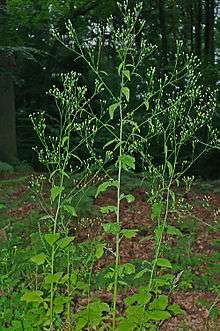Lapsana communis
| Lapsana communis | |
|---|---|
 | |
| Scientific classification | |
| Kingdom: | Plantae |
| (unranked): | Angiosperms |
| (unranked): | Eudicots |
| (unranked): | Asterids |
| Order: | Asterales |
| Family: | Asteraceae |
| Genus: | Lapsana |
| Species: | L. communis |
| Binomial name | |
| Lapsana communis L. | |
| Synonyms[1] | |
|
Synonymy
| |
Lapsana communis, the common nipplewort,[2] is a species of flowering plant in the sunflower family. It is native to Europe and southwestern Asia. and widely naturalized in other regions including North America.[3][4][5]
Description

Nipplewort is an annual[6] or perennial herbaceous plant growing to 1–1.2 m (3 ft 3 in–3 ft 11 in) tall, with erect, hairy branching stems and clear (not milky) sap. The leaves are alternate and spirally arranged; the larger leaves at the base of the flowering stem are often pinnate, with a large oval terminal leaflet and one to four small side leaflets, while smaller leaves higher on the stem are simple oval; all leaves have toothed margins. The flowers are yellow, produced in a capitulum 1–2 cm (0.39–0.79 in) diameter, the capitula being numerous in loose clusters at the top of the stem.[7][8] The capitulum is surrounded by a whorl of involucral bracts, the outer ones very small and the inner ones erect, narrow and stiff and all the same length. The eight to fifteen florets are pale yellow and shaped like a tongue with a five-toothed tip. Each has five stamens and a gynoecium composed of two fused carpels. The fruit is a cypsela surrounded by the hardened remains of the involucral bracts. The numerous small seeds are retained in the cypsela until the plant is shaken by the wind or a passing animal.[9]
- Lapsana communis subsp. adenophora (Boiss.) Rech.f. -- Southeast Europe
- Lapsana communis subsp. alpina (Boiss. & Balansa) P.D.Sell. -- Crimea
- Lapsana communis subsp. communis—Most of Europe, except the southeast
- Lapsana communis subsp. grandiflora (M. Bieb.) P.D.Sell. -- Southwest Asia
- Lapsana communis subsp. intermedia (M. Bieb.) Hayek. -- Southwest Asia, southeast Europe
- Lapsana communis subsp. pisidica (Boiss. & Heldr.) Rech.f. -- Greece
Cultivation and uses
The young leaves are edible, and can be used in salads or cooked like spinach.[12] The scientific name comes from Lapsane, an edible herb described by Marcus Terentius Varro of ancient Rome. The English name 'Nipplewort' derives from its closed flower buds, which resemble nipples. Because of its resemblance to nipples, under the doctrine of signatures it was once used as treatment for breast ulcers.[13]
Ecology
Nipplewort is found growing in arable fields, woods, hedges,[6] roadsides, wasteland, hedgerows, woodland margins and clear-felled areas in forests.[9]
Distribution
Away from its native area, Lapsana communis is common throughout the British Isles,[14] naturalised, and sometimes considered an invasive species, in many areas around the world, including Australia,[15] Chile,[16] New Zealand,[17] Greenland,[18] and most of Canada and the United States.[18]
See also
References
- 1 2 The Plant List Lapsana communis L.
- ↑ "Lapsana communis". Natural Resources Conservation Service PLANTS Database. USDA. Retrieved 18 January 2016.
- ↑ Altervista Flora Italiana, genere Lapsana
- ↑ Flora of North America, Lapsana communis Linnaeus, Sp. Pl. 2: 811. 1753.
- ↑ Biota of North America Program 2014 county distribution map
- 1 2 Parnell, J. and Curtis, Y. 2012 Webb's An Irish Flora. Cork University Press. ISBN 978-185918-4783
- 1 2 Flora of Northwestern Europe: Lapsana communis
- ↑ Blamey, M. & Grey-Wilson, C. (1989). Flora of Britain and Northern Europe. ISBN 0-340-40170-2
- 1 2 "Nipplewort: Lapsana communis". NatureGate. Retrieved 2013-12-30.
- ↑ Flora Europaea: [ Lapsana communis]
- ↑ Germplasm Resources Information Network: Lapsana communis
- ↑ Plants for a Future: Lapsana communis.
- ↑ Parkinson, J. (1640). Theatrum Botanicum; or an Herball of Large Extent.
- ↑ Clapham, A.R., Tutin, T.G. and Warburg, E.F. 1968. Excursion Flora of the British Isles. Cambridge University Press. ISBN 0 521 04656 4
- ↑ Flora of New South Wales: Lapsana communis.
- ↑ Flora of Chile: Lapsana communis.
- ↑ Flora of New Zealand: Lapsana communis.
- 1 2 Flora of North America: Lapsana communis.
| Wikimedia Commons has media related to Lapsana communis. |